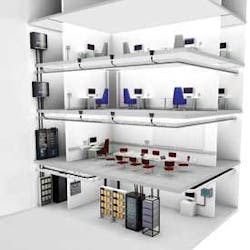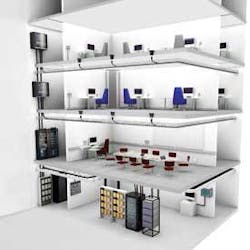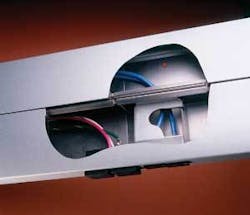by Dale Budenski and Cynthia Montstream
Larger and/or heavier cables affect such issues as conduit fill and bend radius.
Widespread adoption of 10-Gigabit Ethernet (10-GbE) is gaining momentum in data centers and as backbone applications, so it is critical that the design and installation of any structured cabling system takes into account the application’s unique requirements. Every aspect of structured cabling system pathways must be designed to ensure the highest channel performance. Yet today’s familiar pathways and installation methods may not be adequate for new cable technologies that accommodate 10-GbE.
The Telecommunications Industry Association (TIA; www.tiaonline.org) has yet to update the TIA/EIA-569-B standard to address the larger cable needed to support 10-GbE. Factors to consider include the larger diameter of the cable, additional bend radius required, and increased weight of cables, such as Augmented Category 6 UTP (Category 6A) and shielded cables (Category 6 FTP, Category 7 STP). These requirements differ significantly from those of older cable designs and have a direct bearing on the performance of a 10-GbE system.
Next-generation cable
There is no guarantee that Category 6 UTP cable will support 10-GbE transmission for a defined minimum distance. Instead, TIA developed a Telecommunications Systems Bulletin, TSB-155, which defines additional testing guidelines to qualify installed Category 6 UTP and its ability to support 10-GbE. Testing within the Institute of Electrical and Electronics Engineers (IEEE; www.ieee.org) has shown that most Category 6 UTP cables will not support 10-GbE beyond 55 meters, and many do not come close to 55 meters. Category 6A UTP cable is designed to support 10-GbE on a four-connector, 100-meter channel. To provide this higher level of performance-without adding shielding-the cable was redesigned to reduce the effects of alien crosstalk.
Alien crosstalk (electrical noise from other cables) has become the dominant noise source for 10-GbE because external noise cannot be controlled through digital signal processing (DSP) techniques. DSP techniques are only able to eliminate internal cable noise like near-end and far-end crosstalk; and echo cancellation techniques minimize the effect of return loss. The way to minimize alien crosstalk is to provide greater separation between cable pairs or by shielding pairs from neighboring cables.
Category 6A UTP cables have larger overall diameter that provides additional separation between twisted pairs within adjacent cables to reduce alien crosstalk. There are two shielded options that support 10-GbE: Category 6 FTP cables employ foil around all four pairs while Category 7 STP cables have a shield around each pair and an overall shield around all four pairs. The larger diameter and bend radius of these cabling options have a significant impact on the cabling pathway design.
The difference in diameter between Category 6 and Category 6A may seem trivial, but it can have a significant impact on the number of cables that can be accommodated in a particular pathway. For example, TIA recommends that a 0.75-inch (21-mm) conduit will hold two Category 6 cables, but only one Category 6A cable, at 40% fill. Similar capacity reductions are noted for other cabling pathways. System designers should plan for perimeter raceway systems, cable trays, furniture systems, and other pathways to handle the largest cable outside diameter (OD) to be installed for the life of those systems. TIA recommends a minimum of two cables per work area; however, BICSI-suggested best practice is to design pathways for three cables.
The larger bend radius of Category 6 FTP and Category 6A UTP cables also requires more space-in telecommunications rooms, horizontal pathways, and at the workstation-so as to avoid creating tight bends that degrade performance. Additionally, Category 6 FTP and Category 6A UTP cable is heavier than the cable that is currently in use. Caution must be taken so that even if the current TIA guidelines for fill-rate are followed, the additional weight of the cable does not cause problems for the cable at the bottom of the conduit.
Any distortion of the cable jacket could result in performance problems during the life of the system. And because its greater weight makes cable more difficult to pull, pathways that offer in-lay installation may be preferable both for initial installation and to accommodate moves, adds, and changes.
Building-wide impacts
The impact of 10-GbE cabling will be felt throughout the building from the main equipment room to the workstation. (See photo, page 25.) Not only is the twisted-pair copper cabling becoming larger and heavier, but there is an additional need to better manage cable bundle size and to provide adequate separation between cables:
• Entrance facility/equipment room. Cable-management requirements will be impacted by cable diameter, weight, and bend radius. The cable management used must be able to accommodate the additional size and weight of the cable. This will require additional space in the racks, including vertical and horizontal management that will allow random cable placement to minimize alien crosstalk issues. Insufficient cable management may result in cables becoming compressed or kinked, which will result in decreased performance. When selecting a rack solution, make sure it will accommodate the larger bend radius of the backbone cabling; also keep in mind the additional requirements for equipment or patch cords on the front of the rack.
• Telecommunications room. As in the entrance facility, adequate cable support is needed in the telecommunications room. Typically, there are three different cable systems that need to be managed-backbone, horizontal, and cross-connect-introducing a range of cable types from fiber to high-pair-count and the new Category 6A UTP cables. Additionally, telecommunications room space is at a premium, contributing to the need for higher cable density. Racks and cable management must accommodate the routing demands of cables that may be larger, heavier, and require a greater bend radius, often in limited available space.
• Horizontal and backbone pathways. A wide variety of wire and cable management systems are available to support Category 6 FTP and Category 6A UTP cable. The selection of a particular system depends on many factors. Of particular concern is maintaining the proper cable bend radius, supporting extra weight, and providing additional space to manage larger, loose cable bundles.
- Perimeter raceway systems are available in many sizes to accommodate larger cables. New internal configurations have been developed to provide more space for required, larger cable bend radius. And removable covers facilitate lay-in installation.
- Cable tray is a popular pathway solution, but larger trays may be needed when installing Category 6A cable. Trays must have drop-out fittings that meet or exceed bend-radius specifications. Trays and supports must meet higher weight requirements; hooks will not give the support required for large bundles of larger, heavier cabling.
- Underfloor and cellular duct systems offer ample capacity and may be more cost-effective than using conduit to feed floor boxes.
- Conduit must be sized appropriately-a minimum of 1.0 inches for two cables and 1.25 inches for four cables.
• Work areas. Larger diameters and greater bend-radius requirements dictate more spacious housing for cable slack that will be hard to manage in standard wall boxes. Even if the slack is pulled back into the wall, a larger box still must be used to maintain the larger bend radius required. This additional slack-space requirement must be designed into the pathway. Double-gang boxes should be used for two cables, per BICSI recommendations, and it is suggested that triple-gang or larger boxes be used for four cables.
A long-term view
The impact of larger and heavier cables must be considered at every point in both pathways and spaces. Even if an end user is not ready for a 10-GbE system yet, pathways and spaces are static components that have a life expectancy far greater than that of the cabling system, so long-term planning is always a wise choice.
DALE BUDENSKI is with Wiremold/Legrand (www.wiremold.com). CYNTHIA MONTSTREAM is with Ortronics/Legrand (www.ortronics.com). Lylette Macdonald of Ortronics/Legrand also contributed to this article.



